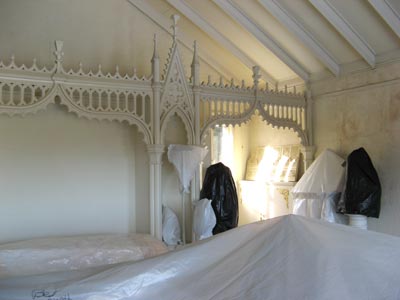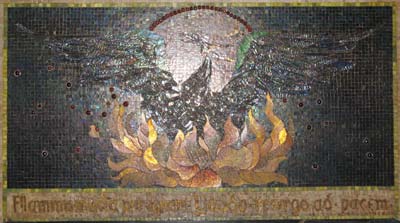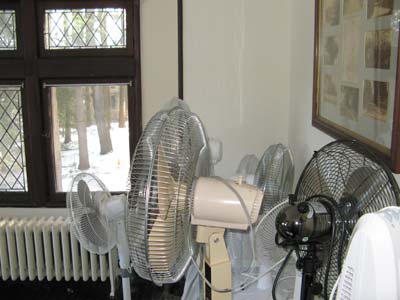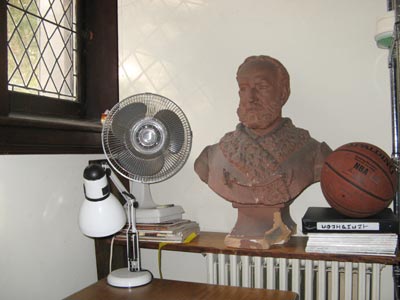frozen in time
We were given a tour of the Yaddo mansion yesterday. It’s closed in the winter, mostly because it’s impossible to heat. We tramped through the great hall, the dining hall, the few fabulous rooms, and the plethora of servants quarters, where most of the writers are housed. The beds wrapped in ghostly plastic, our high-spirited pretend-haunted voices echoing down the empty corridors, our breath chasing, gauzy white as one of Katrina Trask’s gowns; all fifty-five rooms frozen in time, we were just plain frozen.

"One can imagine the whole scene; the chill in the countless rooms, the dry fountain in the atrium, the baptismal fonts and the throne chairs covered with sheets." John Cheever, A Century At Yaddo
Whenever I quote Cheever on Yaddo I feel compelled to balance things out with a word from my friend Camilo, a past guest of Yaddo, who may well terminate our correspondence once he figures out that I’m pillaging his old emails for raw material. I can’t resist. Camilo, like me, is not an American and his descriptions share some of my semi-detached pot-colonial train-wreck fascination with the American Empire:
"The mansion itself, which we visited today, is an impressive scenario of ghostly splendour and opulence. It is a most intriguing and enticing space, tinged with history and everywhere you turn there is another famous name. The people who come here are the cultural "over-achievers" of this country and you hear places like Yale and Harvard being thrown around, but really a good and affable environment, where you meet wonderful people and put on the pounds like a criminal."

Speaking of over-achievers, here is Flannery O'Connor circa 1948 in Katrina Trask's "Tower Room" which many people think of as Truman Capote's room. I was in it yesterday (see above photo) but no-one calls it J. R. Carpenter's room.
To review the Yaddo pre-history: After fighting in the American Revolutionary War Battle of Saratoga Campaign in 1777, Jacobus Barhyte builds a tavern on this site and runs it successfully for the rest of his life. The Barhytes are buried on the grounds. 1856, Dr. Richard S. Childs moves the tavern and builds and ornate Italianate Late Victorian Queen Anne Villa on the site. By 1871 he’s in financial ruin and the villa sits abandoned for ten years. 1881, the Trasks rent the Childs place for a summer get-away. In her Chronicles of Yaddo our benefactress Katrina Trask writes:
"One morning in the late autumn of 1881, I sat in the desolate hall of the hideous old house which we had rented and occupied for five months… It mattered not at all that there were no comforts, not even running water; that the broken locks, open doors and every possible inconvenience tried our patience – if we allowed ourselves to think about them; all that was but as the dust of a high mountain road..."
Katrina’s longwinded, for a poet, but you get the idea: it was a hideous house. It burned down in 1891. An accident? Or a stroke of luck… Either way, the Trasks rebuilt immediately, completing the present mansion in 1893. The fireplace in the great hall sports a Tiffany mosaic of a phoenix rising from the ashes.

The Latin inscription reads:
flammis invicta per ignem Yaddo ad resurgo pacem
Our mansion, as I like to think of the present house, was modeled on Haddon Hall in Derbyshire. One problem with building an Elizabethan English country house in upstate New York is how much colder it is here. And hotter! In the summer, writers toil away to the whirr of electric fans like in the olden days, or, like how we do in Montreal, without any air conditioning.

I doubt I’m cut out for the social strain of a high summer season stay in the mansion, but I know I’ll apply one day. I’m just too curious a person. No matter how small a garret I am granted, no matter how loud it is, no matter how hot the days and bat infested and debauched the nights, and no matter little work I get done, I’d like join the fray just once so I can write about it after. I’m sure there’s a story lurking in every corner. Take this still life, for example. At least a thousand words.

. . . . .

"One can imagine the whole scene; the chill in the countless rooms, the dry fountain in the atrium, the baptismal fonts and the throne chairs covered with sheets." John Cheever, A Century At Yaddo
Whenever I quote Cheever on Yaddo I feel compelled to balance things out with a word from my friend Camilo, a past guest of Yaddo, who may well terminate our correspondence once he figures out that I’m pillaging his old emails for raw material. I can’t resist. Camilo, like me, is not an American and his descriptions share some of my semi-detached pot-colonial train-wreck fascination with the American Empire:
"The mansion itself, which we visited today, is an impressive scenario of ghostly splendour and opulence. It is a most intriguing and enticing space, tinged with history and everywhere you turn there is another famous name. The people who come here are the cultural "over-achievers" of this country and you hear places like Yale and Harvard being thrown around, but really a good and affable environment, where you meet wonderful people and put on the pounds like a criminal."

Speaking of over-achievers, here is Flannery O'Connor circa 1948 in Katrina Trask's "Tower Room" which many people think of as Truman Capote's room. I was in it yesterday (see above photo) but no-one calls it J. R. Carpenter's room.
To review the Yaddo pre-history: After fighting in the American Revolutionary War Battle of Saratoga Campaign in 1777, Jacobus Barhyte builds a tavern on this site and runs it successfully for the rest of his life. The Barhytes are buried on the grounds. 1856, Dr. Richard S. Childs moves the tavern and builds and ornate Italianate Late Victorian Queen Anne Villa on the site. By 1871 he’s in financial ruin and the villa sits abandoned for ten years. 1881, the Trasks rent the Childs place for a summer get-away. In her Chronicles of Yaddo our benefactress Katrina Trask writes:
"One morning in the late autumn of 1881, I sat in the desolate hall of the hideous old house which we had rented and occupied for five months… It mattered not at all that there were no comforts, not even running water; that the broken locks, open doors and every possible inconvenience tried our patience – if we allowed ourselves to think about them; all that was but as the dust of a high mountain road..."
Katrina’s longwinded, for a poet, but you get the idea: it was a hideous house. It burned down in 1891. An accident? Or a stroke of luck… Either way, the Trasks rebuilt immediately, completing the present mansion in 1893. The fireplace in the great hall sports a Tiffany mosaic of a phoenix rising from the ashes.

The Latin inscription reads:
flammis invicta per ignem Yaddo ad resurgo pacem
Our mansion, as I like to think of the present house, was modeled on Haddon Hall in Derbyshire. One problem with building an Elizabethan English country house in upstate New York is how much colder it is here. And hotter! In the summer, writers toil away to the whirr of electric fans like in the olden days, or, like how we do in Montreal, without any air conditioning.

I doubt I’m cut out for the social strain of a high summer season stay in the mansion, but I know I’ll apply one day. I’m just too curious a person. No matter how small a garret I am granted, no matter how loud it is, no matter how hot the days and bat infested and debauched the nights, and no matter little work I get done, I’d like join the fray just once so I can write about it after. I’m sure there’s a story lurking in every corner. Take this still life, for example. At least a thousand words.

. . . . .
Labels: Yaddo


0 Comments:
Post a Comment
<< Home